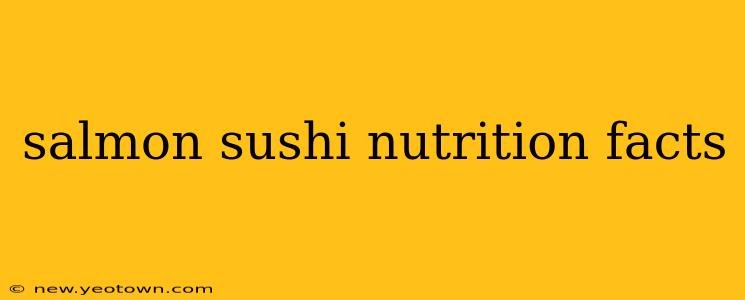Decoding the Deliciousness: A Deep Dive into Salmon Sushi Nutrition
Let's be honest, the vibrant orange slices of salmon in a perfectly crafted sushi roll are a sight to behold. But beyond the aesthetic appeal lies a nutritional powerhouse packed with benefits. This isn't just a delicious meal; it's a healthy choice when crafted thoughtfully. This exploration delves into the nutritional facts of salmon sushi, addressing common questions and uncovering the nutritional nuances.
What are the key nutritional benefits of salmon sushi?
Salmon, the star of the show, is brimming with Omega-3 fatty acids, specifically EPA and DHA. These aren't just buzzwords; they are essential fats our bodies need but can't produce themselves. These beneficial fats contribute to heart health, reducing the risk of cardiovascular disease. Beyond that, salmon is a fantastic source of protein, crucial for building and repairing tissues, and vitamin D, vital for bone health and immune function. The rice, while providing carbohydrates for energy, can also add some fiber, depending on the type used. However, the nutritional profile can significantly change based on the other ingredients incorporated in the sushi.
How many calories are in a salmon sushi roll?
This is where things get a little tricky. The calorie count varies drastically depending on the size of the roll, the type of rice used (white rice generally has more calories than brown rice), and the additional ingredients. A typical six-piece California roll with salmon might hover around 300-400 calories, but a larger, more elaborate roll with creamy sauces and tempura could easily exceed 500 calories. Always check the restaurant's nutritional information if available or make informed choices based on the ingredients.
Is salmon sushi good for weight loss?
Salmon sushi can be part of a weight-loss plan, but it's not a free pass to indulge endlessly. The lean protein in salmon keeps you feeling full and satisfied, which is helpful in managing hunger. The healthy fats also contribute to satiety. However, the overall calorie and carbohydrate content depend on the sushi's preparation. Opt for rolls with minimal added sauces, fried ingredients, or excessive rice to keep the calorie count lower.
What are the potential health risks associated with eating salmon sushi?
While salmon sushi offers numerous health benefits, there are potential risks to consider. The biggest concern is foodborne illness, particularly if the fish isn't handled properly. Ensure you're consuming sushi from reputable establishments known for their food safety practices. Additionally, some individuals may be allergic to salmon or other ingredients in sushi. Be mindful of potential allergies and always inform your server if you have any concerns. Lastly, the sodium content can be high in some sushi rolls due to soy sauce and other seasonings; this is something to watch if you are on a low-sodium diet.
How much salmon sushi should I eat per week?
There's no magic number, as it depends on your overall diet and health goals. However, incorporating salmon sushi a couple of times a week as part of a balanced diet can be a delicious and nutritious addition. Remember to balance it with other healthy foods and consider portion sizes to maintain a healthy lifestyle.
What are some healthy alternatives to salmon sushi?
If you're looking for alternatives, other types of sushi featuring lean fish like tuna or white fish can be equally nutritious. Vegetarian options with avocado or cucumber offer a lower-calorie and equally delicious choice. Remember that the nutritional value varies depending on the chosen ingredients and preparation methods.
This exploration reveals that salmon sushi, while a delectable treat, is also a nutritional powerhouse. By making informed choices about the type of roll, the ingredients used, and the source of your sushi, you can relish its deliciousness while maximizing its health benefits. Remember to always prioritize food safety and be mindful of your individual dietary needs and preferences.

